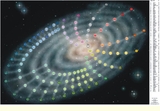Can it get better than a maze made out of books?Yes, it can. The maze is patterned after Jorge Luis Borges’ fingerprints.
250,000 books were assembled by Brazilian artists, Marcos Saboya and Gualter Pupo, who collaborated with production company Hungry Man to create this installation, aMAZEme, being shown and experienced in London, UK. From the Aug. 12, 2012 posting by GrrlScientist for the Guardian science blogs,
Do you think is it possible to bring together such disparate topics as literature, performance art, installation, architecture and cinema? … we see how one man’s love of books and labyrinths (and fingerprints) came together to create an interesting audience-participation installation designed to raise funds to reduce poverty.
… this is [an homage to] Argentinean writer and educator Jorge Luis Borges, celebrating his love of books and labyrinths (and fingerprints?). A smaller version of this piece was previously created in Rio de Janeiro, but the London installation is much more ambitious.
If you happen to be in London, UK between now (Aug. 13, 2012) and Aug. 26, 2012, you can purchase tickets. From a description on the event page,
By participating in the installation, the audience discovers new textures, images and emotions. They become surrounded- hypnotized – by words and thoughts, designs and patterns. There appear to be secrets hidden in the installation’s walls; walls of up to 2.5 metres high, built from thousands of books, forming a large Maze of more than 500 square metres. The construction of the labyrinth and the public’s participation will be filmed by video cameras and sent to the “aMAZEme” website as well as to social media sites. Touch screens will be installed to look up information and to screen content, which will also be shown in monitors throughout the installation.
The public will be able to navigate through this hypnotic and surprising “book labyrinth” or attend daily performances from literary figures.
The artists have provided a time-lapsed video showing the maze as it’s being constructed,
The Aug. 4, 2012 posting on the ART IS ALIVE blog provides this detail,
Projections of literary quotes directly onto the labyrinth walls and the accompanying audio will immerse the audience in a world of literature. Presented for the first time outside of Brazil, aMAZEme has been built in situ from 26 July and visitors can watch it grow over the course of the week. When the maze is deconstructed at the end of the exhibition, all of the books will be donated to Oxfam.
You might also want to check out the aMAZEme labyrinth images in Alice’s July 31, 2012 posting on the My Modern Met blog. For anyone unfamiliar with Jorge Luis Borges, here’s excerpt from a Wikipedia essay (Note: I have removed some links and footnotes),
Jorge Francisco Isidoro Luis Borges (24 August 1899 – 14 June 1986), known as Jorge Luis Borges (Spanish pronunciation: [ˈxorxe ˈlwis ˈβorxes]), was an Argentine short-story writer, essayist, poet and translator born in Buenos Aires. His work embraces the “character of unreality in all literature”. His most famous books, Ficciones (1944) and The Aleph (1949), are compilations of short stories interconnected by common themes such as dreams, labyrinths, libraries, mirrors, animals, fictional writers, philosophy, religion and God.
I wonder if anyone is tempted to pull a book from the maze for closer examination and what would happen. That’s always my impulse when I see a mass of books. There’s usually something I’d like to examine more closely.
